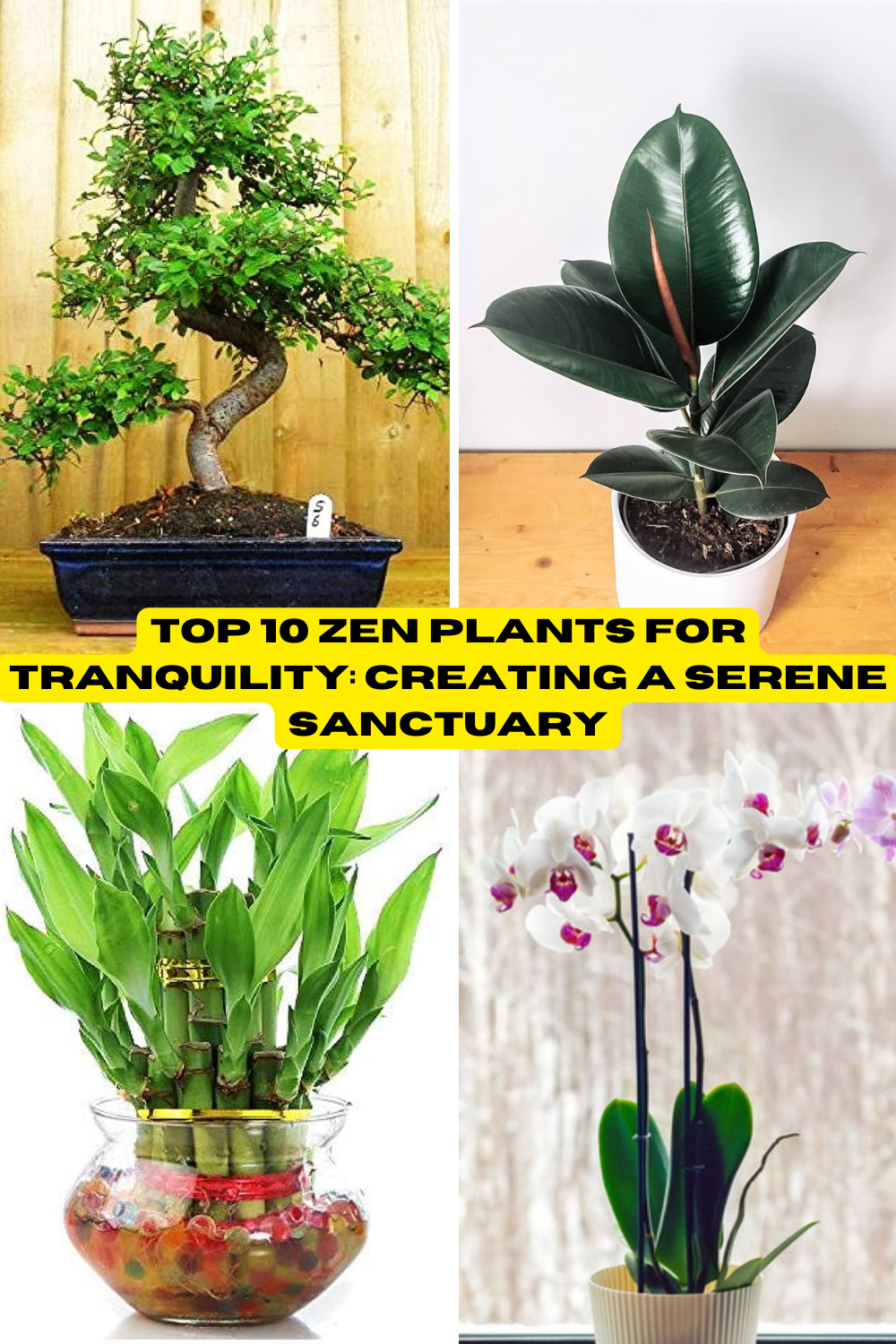Creating a Zen plant space at home brings tranquility and balance to your environment. Embrace the calming presence of nature with easy-care Zen plants for home that purify the air and enhance your décor. Discover how to curate a serene oasis with our tips for choosing and maintaining the perfect Zen plants.
1. Bonsai Tree
Bonsai trees are miniature trees that are meticulously cultivated to remain small while maintaining the shape and style of full-sized trees. The art of bonsai involves growing these trees in containers and carefully managing their growth through various techniques.
Care:
- Watering: Bonsai trees require precise watering. The soil should be kept moist but not waterlogged. The frequency of watering depends on the type of tree, the climate, and the season.
- Pruning: Regular pruning is essential to maintain the desired shape and size. This includes trimming both the branches and roots.
- Sunlight: Adequate sunlight is crucial for the health of a bonsai tree. Most bonsai trees prefer several hours of direct sunlight each day, but the specific needs can vary based on the species.
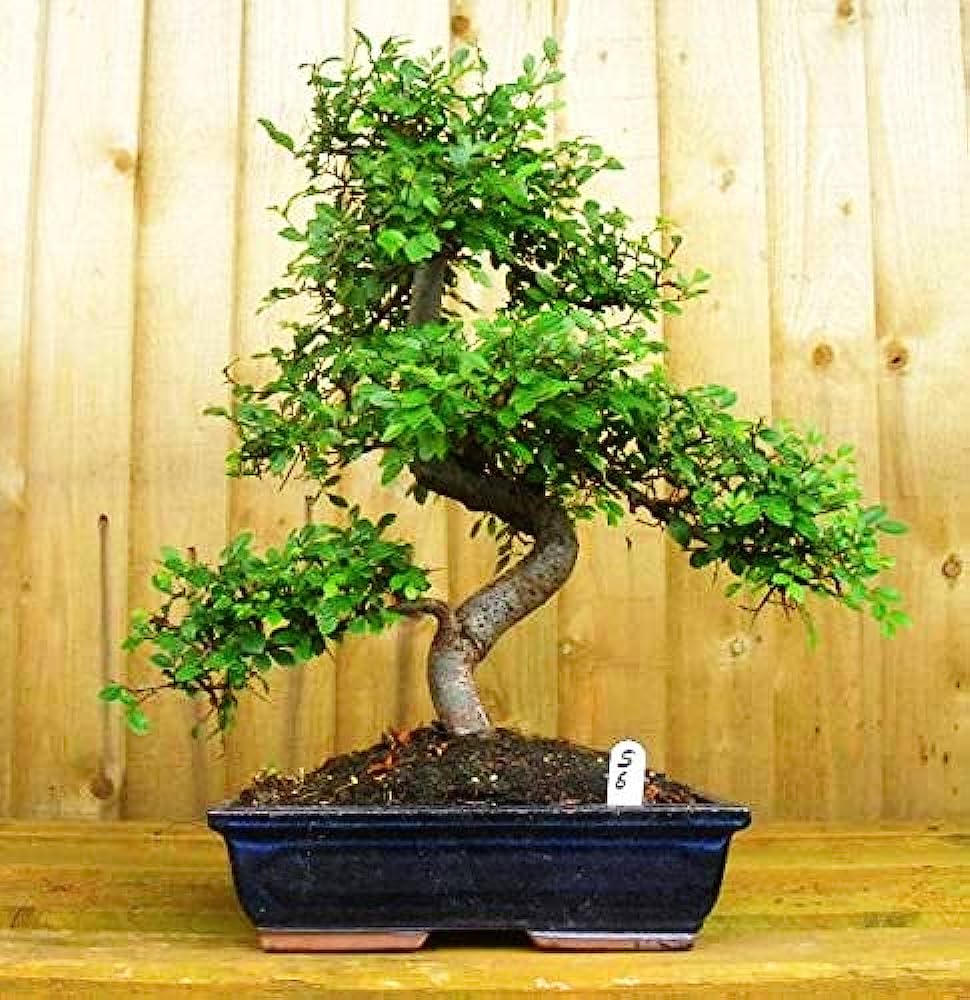
Benefits:
- Symbolism: Bonsai trees symbolize harmony, peace, and balance, reflecting the natural world’s tranquility and the meticulous care required to cultivate them.
- Aesthetic Appeal: They are often used as decorative pieces due to their unique and elegant appearance.
- Therapeutic Value: The process of caring for a bonsai tree can be meditative and stress-relieving, promoting mindfulness and relaxation.
2. Bamboo (Lucky Bamboo)
Lucky Bamboo is a popular plant known for its association with good fortune and resilience. Despite its name, it is not a true bamboo but belongs to the Dracaena genus. Its distinctive stalks and leaves are often arranged in decorative patterns
Care:
- Water: Lucky Bamboo grows well in water with pebbles to support the stalks or in well-draining soil. When grown in water, it should be kept clean and changed every two to four weeks to prevent root rot.
- Sunlight: It thrives in indirect sunlight. Direct sunlight can scorch the leaves, so it’s best placed in a spot with bright, filtered light.
- Environment: It prefers a warm and humid environment, making it well-suited for indoor cultivation.
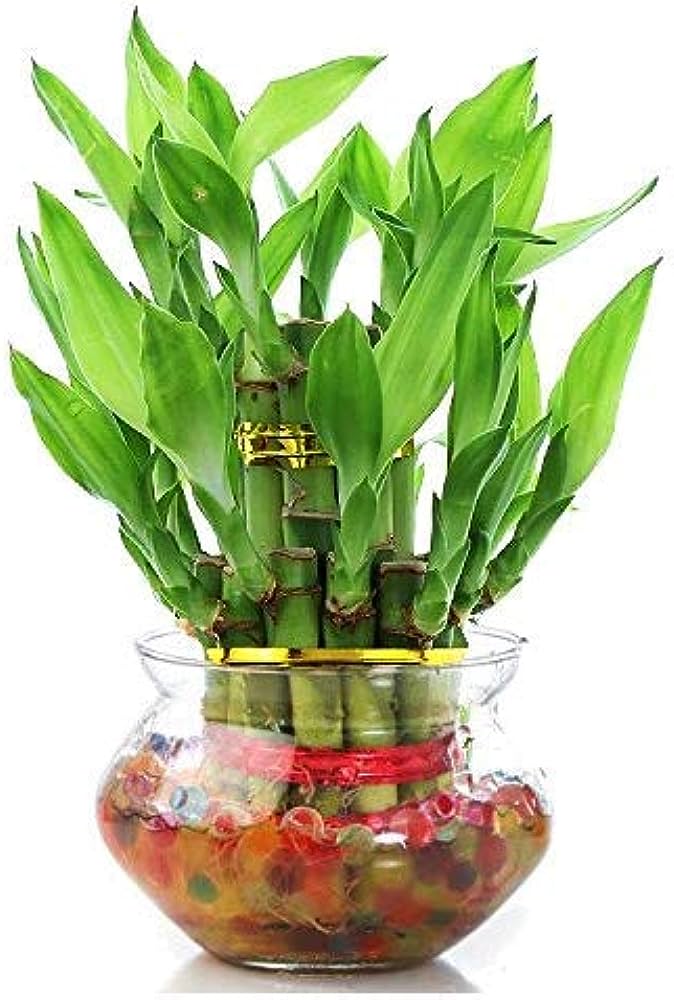
Benefits:
- Ease of Care: Lucky Bamboo is low-maintenance, making it ideal for beginners or those with busy lifestyles.
- Aesthetic Appeal: The plant can be shaped and twisted into various designs, adding a unique and artistic touch to home or office décor.
- Symbolism: It is often gifted as a symbol of good luck, prosperity, and positive energy, making it a thoughtful and meaningful present.
3. Peace Lily (Spathiphyllum)
The Peace Lily is a popular houseplant renowned for its lush, dark green leaves and elegant white flowers, which are actually specialized leaf bracts surrounding the true flowers.
Care:
- Light: Peace Lilies thrive in low to medium light conditions. They can tolerate low light but may produce more flowers with moderate, indirect light.
- Watering: They prefer consistently moist soil but should not be waterlogged. Water approximately once a week, allowing the soil to dry slightly between waterings. The leaves may droop when the plant needs water, serving as a natural indicator.
- Environment: Peace Lilies enjoy a warm, humid environment and should be kept away from cold drafts and direct sunlight, which can scorch the leaves.
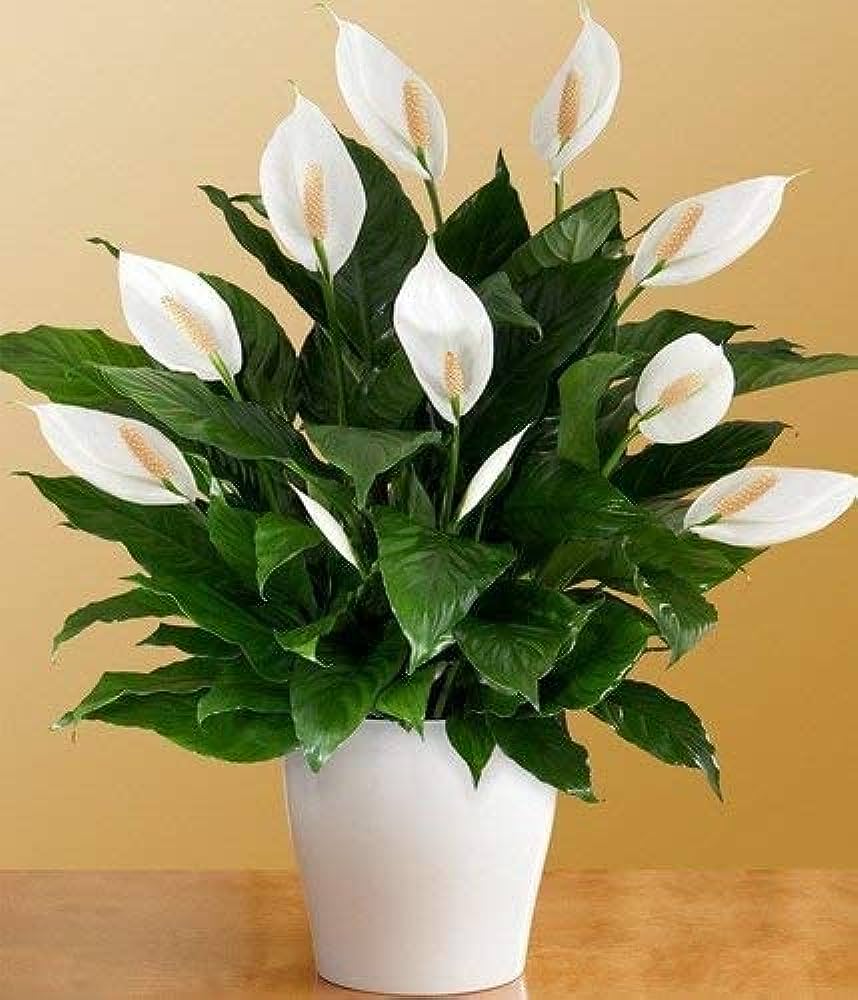
Benefits:
- Air Purification: Peace Lilies are excellent at improving indoor air quality. They filter out common pollutants such as benzene, formaldehyde, and trichloroethylene, making the air cleaner and healthier to breathe.
- Aesthetic Appeal: Their striking appearance adds a touch of elegance to any room, enhancing the visual appeal of indoor spaces.
- Low Maintenance: They are relatively easy to care for, making them a good choice for those new to houseplants or those looking for low-effort greenery.
4. Jade Plant (Crassula ovata)
The Jade Plant, also known as Crassula ovata, is a succulent with thick, shiny, and fleshy leaves that often resemble jade stones. It is a popular houseplant, admired for its attractive, tree-like appearance and longevity.
Care:
- Light: Jade Plants require bright light to thrive. They do best in direct sunlight, making a sunny windowsill an ideal location.
- Watering: These succulents need minimal watering. Allow the soil to dry out completely between waterings, as overwatering can lead to root rot. Watering once every few weeks is typically sufficient, especially in cooler months.
- Soil: Well-draining soil is essential to prevent water retention. A cactus or succulent mix works well.
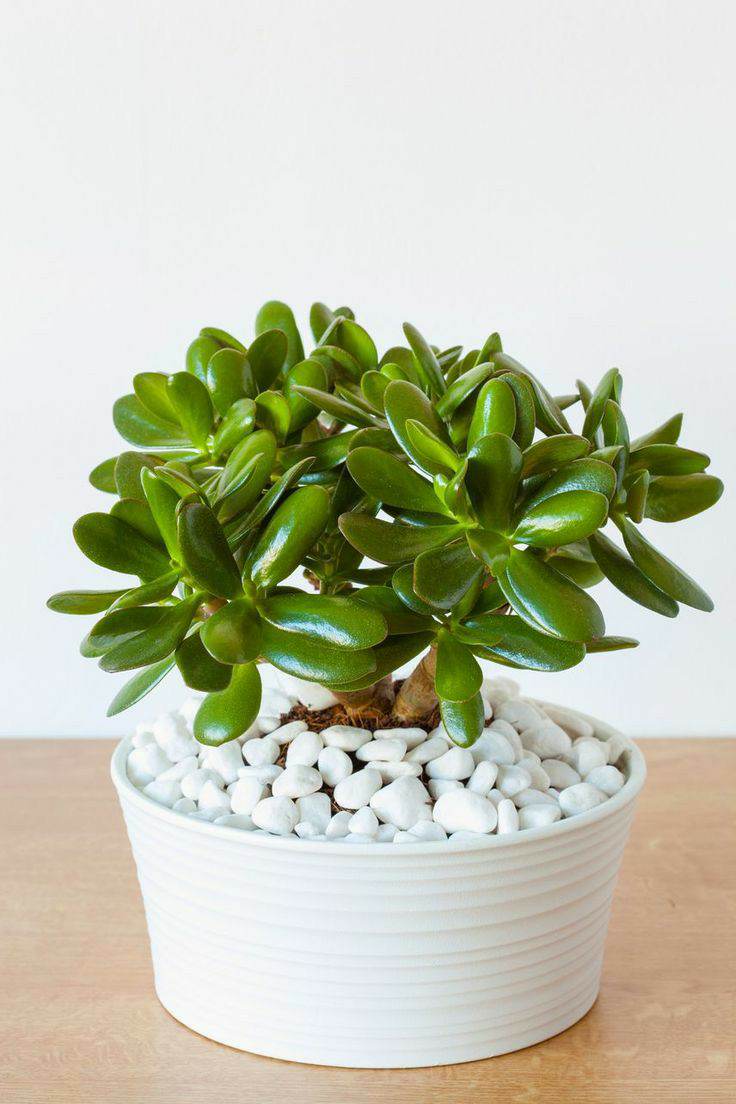
Benefits:
- Symbolism: The Jade Plant is often associated with good luck, prosperity, and wealth, making it a popular gift for new business ventures or to bring positive energy into the home.
- Aesthetic Appeal: Its thick, glossy leaves and compact growth habit make it an attractive addition to indoor spaces, adding a touch of greenery with minimal care requirements.
- Low Maintenance: As a succulent, it is easy to care for and can tolerate periods of neglect, making it ideal for busy individuals or those new to houseplants.
5. Orchids
Orchids are exotic flowering plants known for their stunning and diverse blooms that come in a wide array of colors and patterns. They are prized for their beauty and unique, intricate flowers.
Care:
- Light: Orchids thrive in indirect sunlight. They should be placed in a location with bright, filtered light, avoiding direct sun exposure which can scorch their leaves.
- Watering: Orchids have specific watering needs, often requiring water once a week. The roots should be allowed to dry out slightly between waterings to prevent root rot. It’s best to water orchids in the morning to ensure the foliage dries out by evening.
- Humidity and Airflow: They prefer a humid environment with good air circulation. Placing a humidity tray with water near the plant or using a humidifier can help maintain the necessary humidity levels.

Benefits:
- Aesthetic Appeal: Orchids add a touch of elegance and luxury to any space. Their exotic and vibrant flowers can serve as a striking focal point in home or office decor.
- Variety: With numerous species and hybrids available, orchids offer a wide range of choices in terms of colors, sizes, and shapes, allowing for personalized decoration.
- Long-Lasting Blooms: Orchids can bloom for several weeks to months, providing long-lasting beauty and enjoyment with proper care.
6. Fern (Boston Fern)
The Boston Fern is a popular houseplant recognized for its feathery, arching fronds that create a lush, green display. Its graceful and delicate foliage makes it a favorite for adding a touch of nature indoors.
Care:
- Light: Boston Ferns thrive in indirect light. They should be placed in a location with bright, filtered light but can also tolerate low light conditions.
- Watering: They prefer consistently moist soil. Regular watering is essential, but the soil should not be soggy. Allow the top inch of soil to dry out between waterings.
- Humidity: Boston Ferns require a humid environment to thrive. Regular misting and placing the plant on a humidity tray can help maintain the necessary moisture levels. They also benefit from being in rooms like bathrooms where humidity levels are naturally higher.

Benefits:
- Air Purification: Boston Ferns are excellent at filtering pollutants from the air, including formaldehyde and xylene, making the indoor air cleaner and healthier.
- Aesthetic Appeal: Their lush, green fronds add a vibrant and refreshing touch to indoor spaces, enhancing the overall aesthetic with a natural and relaxing vibe.
- Stress Relief: Having greenery like Boston Ferns in the home can improve mood and reduce stress, contributing to a more calming and pleasant environment.
7. Snake Plant (Sansevieria)
The Snake Plant, also known as Sansevieria or Mother-in-Law’s Tongue, is characterized by its upright, sword-like leaves that can vary in color from green with yellow edges to silver and green striped patterns. This hardy plant is known for its architectural appeal and resilience.
Care:
- Light: Snake Plants tolerate a wide range of light conditions, from low light to bright, indirect sunlight. They can even survive in fluorescent light, making them ideal for offices and darker rooms.
- Watering: These plants require minimal watering. Allow the soil to dry out completely between waterings, typically watering every 2-6 weeks depending on the environment. Overwatering can lead to root rot.
- Soil: Well-draining soil is crucial for Snake Plants. A cactus or succulent mix works well to prevent water from pooling around the roots.

Benefits:
- Air Purification: Snake Plants are excellent at filtering indoor air pollutants such as formaldehyde, benzene, trichloroethylene, and xylene. They also have the unique ability to convert CO2 into oxygen at night, making them beneficial for improving air quality in bedrooms.
- Low Maintenance: Their tolerance for low light and infrequent watering makes them one of the easiest houseplants to care for, perfect for beginners or those with busy schedules.
- Aesthetic Appeal: The upright, sword-like leaves add a modern and striking visual element to any indoor space, enhancing both contemporary and traditional decor styles.
8. Aloe Vera
Aloe Vera is a succulent plant known for its thick, fleshy leaves that contain a soothing gel with various medicinal properties. This plant is widely appreciated for both its ornamental value and practical uses.
Care:
- Light: Aloe Vera thrives in bright, indirect light. It can also handle some direct sunlight but prefers a sunny spot with filtered light.
- Watering: Aloe Vera requires minimal watering. Allow the soil to dry out completely between waterings, typically watering every 3-4 weeks. Overwatering can cause root rot.
- Soil: Use well-draining soil, such as a cactus or succulent mix, to prevent water retention around the roots.

Benefits:
- Air Purification: Aloe Vera helps improve indoor air quality by filtering out pollutants like formaldehyde and benzene.
- Medicinal Uses: The gel inside Aloe Vera leaves has anti-inflammatory and healing properties. It can be applied directly to the skin to soothe burns, cuts, and other minor skin irritations.
- Low Maintenance: Aloe Vera is easy to care for, making it ideal for beginners or those looking for a low-effort plant with both decorative and practical benefits.
- Aesthetic Appeal: Its spiky, fleshy leaves add a distinctive and attractive look to indoor spaces, complementing both modern and traditional decor.
9. Rubber Plant (Ficus elastica)
The Rubber Plant is a popular houseplant recognized for its large, glossy, and dark green leaves. It is a striking and robust plant that can grow quite tall, adding a bold, tropical feel to any indoor space.
Care:
- Light: Rubber Plants prefer bright, indirect light. They can tolerate lower light conditions but may grow more slowly and lose some of their vibrant color.
- Watering: These plants require moderate watering. Keep the soil consistently moist but not waterlogged. Allow the top inch of soil to dry out between waterings. During the growing season (spring and summer), they may need more frequent watering, while in the dormant season (fall and winter), watering can be reduced.
- Humidity: Rubber Plants appreciate higher humidity but can adapt to average household humidity levels. Misting the leaves occasionally can help maintain humidity and keep the leaves clean.
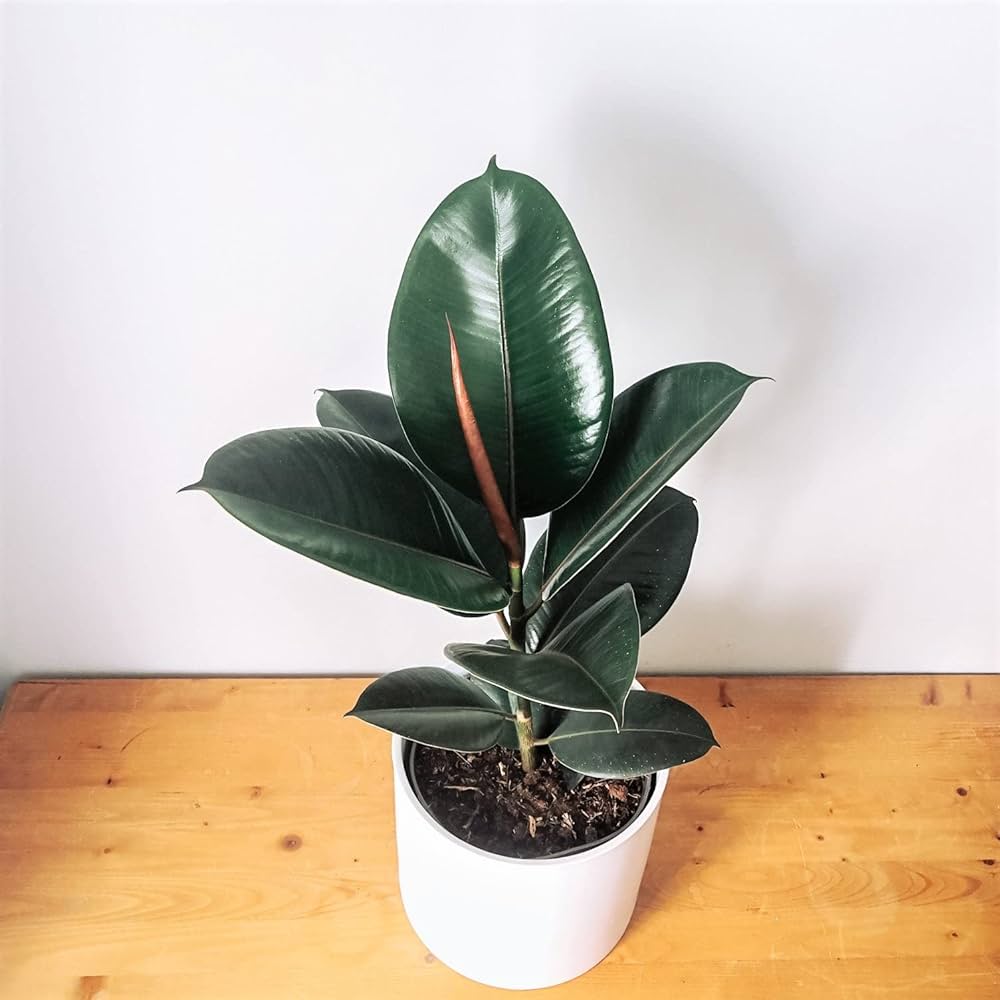
Benefits:
- Air Purification: Rubber Plants are excellent air purifiers. They help filter out toxins such as formaldehyde, making the indoor environment healthier.
- Aesthetic Appeal: With their large, glossy leaves and robust structure, Rubber Plants make a bold statement in any room, adding a touch of the tropics to indoor decor.
- Low Maintenance: Rubber Plants are relatively easy to care for, making them suitable for both novice and experienced plant enthusiasts. Their adaptability to different light conditions and moderate watering needs make them a versatile choice for various indoor settings.
10. ZZ Plant (Zamioculcas zamiifolia)
The ZZ Plant, known scientifically as Zamioculcas zamiifolia, is a popular houseplant appreciated for its attractive, waxy, dark green leaves. Its upright growth habit and glossy foliage make it a stylish and resilient addition to any indoor space.
Care:
- Light: ZZ Plants tolerate a wide range of light conditions, from low light to bright, indirect sunlight. They are well-suited for low-light areas such as offices or rooms with limited natural light.
- Watering: This plant is highly drought-tolerant and requires infrequent watering. Allow the soil to dry out completely between waterings, typically every 2-3 weeks. Overwatering can lead to root rot.
- Soil: Well-draining soil is essential for ZZ Plants. A standard potting mix with added perlite or sand works well to ensure good drainage.

Benefits:
- Hardiness: ZZ Plants are extremely low maintenance, making them ideal for busy individuals or those new to houseplants. They can withstand neglect and still thrive.
- Air Purification: ZZ Plants are effective at filtering indoor air pollutants, including xylene, toluene, and benzene, contributing to a healthier living environment.
- Aesthetic Appeal: The waxy, dark green leaves add a sleek and modern touch to any space, enhancing both contemporary and traditional decor styles. The plant’s robust nature and minimal care requirements make it a versatile and appealing choice for home and office settings.
Tips for Maintaining a Zen plants for home:
- Consistency: Regularly check the watering needs and light conditions of your plants.
- Simplicity: Choose plants that suit your environment and lifestyle for ease of maintenance.
- Arrangement: Group plants in a harmonious way that promotes balance and visual calm.
- Cleanliness: Keep leaves dust-free to enhance their appearance and health.
